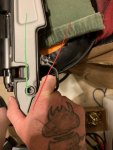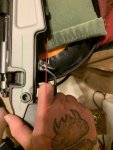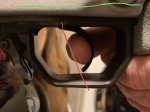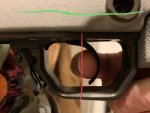Based on the two topics, "Is Marksmanship Dead" and Equipment Versus Shooter" and the comments engendered.
I know nobody here needs to read what is about to be posted, but it's been around a long time and used by a lot of people and covers fundamentals pretty well. I know, reticle is mispelled throughout the whole thing.
And it's not about iron sights, I don't have that one handy right now, but maybe I can dig the iron sight one out and post it too. Maybe.
*HOW TO HOLD AND SHOOT YOUR RIFLE: Aka Fundamentals of Marksmanship.
*How to Hold, *Aim, *Eye Relief, *Sight Alignment, *Sight Picture, *Breathing, *Trigger Manipulation, *Follow Through, and *Recovery.
Now that your rifle fits you properly and you have learned to properly clean and maintain your rifle, you must learn how to hold the rifle. ACCURACY IS A FUNCTION OF CONSISTENCY, BOTH WITH THE RIFLE AND AMMUNITION, AND THE SHOOTER'S ACTIONS. You must hold the rifle the same way each time. You will practice holding the rifle, your sight picture, your breathing, and trigger manipulation through dry firing. You will practice building a good steady, stable, solid position each time, bone on bone, not held by muscle power. Although you have to exert some muscle control, the position should be a natural relaxed position to avoid muscle fatigue, tension, and shaking that occurs after muscles are overextended for any period of time. You will check your natural point of aim before each shot. NATURAL POINT OF AIM is a position that allows the rifle to point naturally at the target without any muscle tension required to hold it on point of aim. You should keep the same position each time, changing nothing, to maintain consistency, to keep your natural point of aim the same each time. Before beginning this portion, or preceding sections, or any exercises, you should stretch first to loosen up your muscles. Besides the natural relaxing effect of stretching, it helps to prepare you mentally as well. Being physically fit will help you shoot better, and if you are not physically fit, you should make it a point to become fit.
*HOW TO HOLD YOUR RIFLE:
Assume the prone supported firing position.
The front of the rifle will rest either on a bipod attached to the stock or on a sandbag placed under the front of the stock.
Use the nonfiring hand to support the butt of the rifle. Place your hand next to your chest and rest the TIP of the butt of the rifle on top of your hand. Ball your hand into a fist to raise the butt of the rifle or relax your fist to lower the butt of the rifle. A preferred method is to use a sock filled with sand or a small sand bag placed in your non firing hand and squeeze it to raise the rifle butt and release the bag to lower the rifle butt. Using this sock or bag method lessens body contact with the rifle and can eliminate an added human variable.
Place the butt of the rifle firmly in the pocket of the shoulder. The sniper can place a pad in his clothing in the pocket of his shoulder to reduce pulse beat and breathing movement.
With the firing hand, grip the the small or pistol grip of the stock. Using the middle through little fingers, exert a slight rearward pull to keep the butt of the rifle firmly in the pocket of the shoulder. Place the thumb over the top of the pistol grip of the stock. Place the index or trigger finger on the trigger and insure it does not touch the stock and does not disturb the lay of the rifle when the trigger is pulled.
Find a comfortable position for your elbows that provide the greatest support for you and your rifle without creating a strain.
Place your cheek in the same place on the stock each time. This is called the stock weld. Changing your position changes sight alignment and will cause misplaced shots.
*AIMING THE RIFLE:
Begin the aiming process by aligning the rifle with the target when assuming a firing position. THE RIFLE SHOULD POINT NATURALLY AT THE DESIRED AIMING POINT. No muscular tension or movement should be neccessary to hold the rifle on target. To check the Natural Point of Aim (NPA), you assume a comfortable, STABLE, firing position. Place your cheek on the stock at the correct stock weld and breath, and entering the natural respiratory pause, look away from the scope moving only your eye and relax. Let the rifle drift to its natural point of aim, then look back through the scope. If the crosshairs remain on the correct position on the target, the natural point of aim is correct.
If the NPA is not correct, you must change your body position to bring the sights on the target. If muscles are used to bring the rifle to NPA, the muscles will relax when the rifle is fired and the rifle will begin to move to its NPA. Because this movement begins just before the weapon discharges, the rifle is moving at the bullet leaves the muzzle. This causes displaced shots with no apparent cause as recoil disguises the movement. By adjusting the rifle and body as a single unit, rechecking, and readjusting as necessary, you achieve a true natural point of aim. Once this position of established, you will them aim the rifle at the exact point on the target. Aiming involves three areas, eye relief, sight alignment, and sight picture.
*EYE RELIEF:
This is the distance from the firing eye to the scope tube. This distance is fairly constant with a scope. You should take care to avoid injury by the scope tube striking the eyebrow during recoil.
You should place your head as upright as possible behind the scope with your eye directly behind the scope. This head placement allows the muscles around your eye to relax. Incorrect head placement causes you to have to look out the corner of your eye resulting in muscle strain, causing blurred vision and eye strain. Eye strain can be avoided by not staring through the scope for long periods of time and correct stock weld alleviates eye strain as well by maintaining consistent eye relief.
*SIGHT ALIGNMENT:
Sight alignment is the relationship between the crosshairs (reticle) and field of view. You must place your head behind the scope so a full field of view appears in the scope tube with NO DARK SHADOWS OR CRESENTS. Center the reticle in a full field of view with the vertical crosshair straight up to ensure the scope is not canted.
*SIGHT PICTURE:
Sight picture is centering the reticle with a full field of view on the target as seen by you. Place the reticle crosshairs on what portion of the target you wish to hit.
*BREATHING:
You must exercise breathing control during the aiming process. Breathing while trying to aim, with the natural up and down motion of the chest while breathing, causes the rifle to move up and down. Up and down movement occurs while laying down. Breathing movement can be side to side when sitting at a bench rest type table when your body is against the table. You must therefore accomplish sight alignment while breathing and finish aiming while holding your breath. You do this by inhaling, exhaling, and stop at the moment of natural respiratory pause before beginning to inhale again.
A respiratory cycle lasts four to five seconds. Inhalation and exhalation take only about two seconds, thus between each respiratory cycle there is a pause of two to three seconds. This pause can be extended to ten seconds without any special effort or unpleasant sensations. You should fire during this pause when your breathing muscles are relaxed. This avoids strain on the diaphragm.
You should assume your firing position and breath naturally until your hold begins to settle.
The respiratory pause should never feel un-natural. If it is too long, the body suffers from oxygen deprivation and begins to send out signals to resume breathing. These signals produce involuntary movements of the diaphragm which interfere with the shooters concentration and lack of movement needed to make a shot.
*TRIGGER CONTROL:
Trigger control is the most important fundamental of sniper marksmanship. It is defined as causing the rifle to fire when the sight picture is at its very best, without causing the rifle to move. Trigger Squeeze on the other hand is defined as the independent action of the forefinger on the trigger with a uniformly increasing pressure on the trigger straight to the rear until the rifle fires. Trigger Control is the last task to be accomplished before the rifle fires.
Proper trigger control occurs when the sniper places his firing finger as low on the trigger as possible and still clears the trigger guard, thereby achieving maximum mechanical advantage. He engages the trigger with that part of his firing finger (middle of the pad of the last digit) that allows him to pull the trigger straight to the rear. In order to avoid transferring movement of the finger to the entire rifle, the sniper should see daylight between the trigger finger and the stock as he squeezes the trigger straight to the rear. He fires the weapon when the reticle is in a position to insure a properly placed shot, or when the reticle is on target.
As the stability of a firing position decreases, the wobble area increases. The larger the wobble area, the harder it is to fire the shot without reacting to it, attempting to influence the sight placement when the trigger breaks. This reaction occurs when the sniper:
1. Anticipates recoil. The firing shoulder begins to move forward just before the rifle fires, thus pushing the rifle out of line with the target.
2. Jerks the Trigger. The trigger finger moves the trigger in a quick, choppy, spasmodic attempt to fire the shot before the reticle can move from the desired point of aim.
3. Flinches. The sniper's entire body (or parts thereof) overreacts to the anticipated noise or recoil (jerks). This is usually due to unfamiliarity with the weapon.
4. Avoids Recoil. The sniper tries to avoid recoil or noise by moving away from the weapon or by closing the firing eye just before the weapon fires. This again is caused by unfamiliarity with the weapon and a lack of knowledge of the weapon's actions upon firing.
Trigger control is best handled by by assuming a stable position, adjusting on the target, and beginning a breathing cycle. As the sniper exhales the final breath approaching the natural respiratory pause, he secures his finger on the trigger. As the reticle settles on the target at the desired point of aim, and the natural respiratory pause is entered, the sniper applies initial pressure to the trigger. He increases the tension on the trigger during the respiratory pause as long as the reticle remains on the desired point of aim to insure a properly placed shot. If the reticle moves away from the desired point of aim, and the respiratory pause is free of strain or tension, the sniper stops increasing the tension on the trigger, waits for the reticle to return to the desired point of aim, and then continues to squeeze the trigger. This is trigger control. If movement is too large for recovery, or if the respiratory pause has become uncomfortable (extended too long), then the sniper should whenever possible, release the pressure off the trigger and start the respiratory cycle again.
*FOLLOW THROUGH:
Applying the fundamentals increases the odds of a well aimed shot being fired. There are however, additional skills, that when mastered, make the first round correct hit even more of a certainty. One of these skills is follow through.
a. This is the act of continuing to apply all the sniper marksmanship fundamentals as the weapon fires as well as after the weapon fires. Follow through consists of:
* Keeping the head in firm contact with the stock (stock weld) upon firing and after firing.
* Keeping the finger on the trigger pulling all the way to the rear when and after the weapon fires.
* Continuing to look through the scope when and after the weapon fires.
* Insuring the muscles stay relaxed when and after the weapon fires.
* Avoid reacting to the recoil or noise during and after firing.
* Releasing the trigger only after the recoil has stopped.
b. Good follow through insures that the weapon is allowed to fire and recoil naturally, and the sniper/rifle combination reacts as a single unit to such actions.
*CALLING THE SHOT:
Calling the shot is being able to tell where the bullet should impact on the target. The sniper must be able to accurately call the shots. Proper follow through will aid in calling the shot. The dominant factor in calling the shot is, whereever the reticle is when the shot is fired. This location is called the final focus point.






